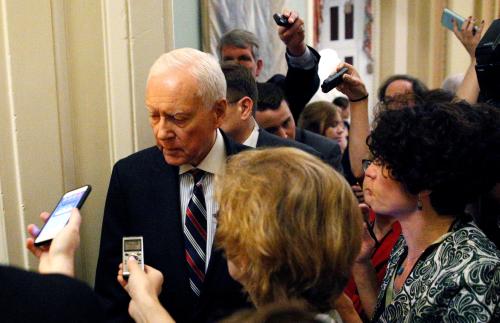This analysis is part of The Leonard D. Schaeffer Initiative for Innovation in Health Policy, which is a partnership between the Center for Health Policy at Brookings and the USC Schaeffer Center for Health Policy & Economics. The Initiative aims to inform the national health care debate with rigorous, evidence-based analysis leading to practical recommendations using the collaborative strengths of USC and Brookings.
Last week, House Republicans unveiled an amendment to the American Health Care Act (AHCA) that would allow states to waive certain insurance market regulations introduced by the Affordable Care Act (ACA), including the “essential health benefit” standards that govern what services must be covered by plans sold in the individual and small group insurance markets. Most analyses of the so-called MacArthur Amendment’s potential effects have focused on what would happen in states that actually adopt waivers. While those effects would often be very significant, waivers of the federal essential health benefit standards under the MacArthur Amendment could also have effects that cross state lines. (I wrote about the potential effects of allowing states to define their own “essential health benefit” standards when a similar proposal was introduced in March. This post addresses the new MacArthur Amendment specifically and provides more detail on why waivers in one state could have effects elsewhere.)
In particular, a single state’s decision to weaken or eliminate its essential health benefit standards could weaken or effectively eliminate the ACA’s guarantee of protection against catastrophic costs for people with coverage through large employer plans in every state. [1] The two affected protections are the ACA’s ban on annual and lifetime limits, as well as the ACA’s requirement that insurance plans cap enrollees’ annual out-of-pocket spending. Both of these provisions aim to ensure that seriously ill people can access needed health care services while continuing to meet their other financial needs.
In particular, a single state’s decision to weaken or eliminate its essential health benefit standards could weaken or effectively eliminate the ACA’s guarantee of protection against catastrophic costs for people with coverage through large employer plans in every state.
Understanding why a single state’s waiver could undermine the ACA’s protections against catastrophic costs nationwide requires delving into the details of how these ACA provisions work. In brief, the ACA generally banned private insurance plans from imposing annual or lifetime limits on the dollar amount of care they would cover and required plans to cap enrollees’ annual out-of-pocket spending.[2] (A majority of employer plans imposed lifetime limits prior to the ACA, and more than one-sixth lacked limits on out-of-pocket spending.) However, the ACA’s ban on annual and lifetime limits only applies with respect to care that is considered essential health benefits. Similarly, the ACA only requires that plans cap enrollees’ annual out-of-pocket spending on care that is considered essential health benefits. Thus, as the definition of essential health benefits narrows, the scope of these requirements narrows as well. Indeed, if nothing was considered an essential health benefit, then these requirements would be completely meaningless.
The breadth of these requirements therefore depends crucially on which definition of essential health benefits applies to any particular plan. For individual and small group market plans, the applicable definition is simply the definition that applies in the state of issuance. But the situation is more complicated for large employer plans, which accounted for around 86 percent of total enrollment in private employer plans in 2015, corresponding to around 110 million enrollees nationwide.[3] These plans are not subject to essential health benefit requirements when determining what types of health care they must cover; the definition of essential health benefits matters only for determining the scope of the required protections against catastrophic costs. These plans are also particularly likely to cover individuals working in multiple states. In light of these complexities, current regulations and guidance permit large employer plans to apply any state’s definition of essential health benefits for the purposes of determining the scope of the ban on annual and lifetime limits and the requirement to cap out-of-pocket spending.
Under current law, allowing large employer plans this type of flexibility has limited impact since all states’ essential health benefit definitions are required to meet basic federal standards. But if each state could set its own definition of essential health benefits, as states would be allowed to do under the MacArthur Amendment, the consequences of allowing this flexibility would be significant.
Suppose that even one state secured a waiver that allowed it to drop maternity services, mental health services, or prescription drugs from the definition of essential health benefits—a plausible scenario since these services were commonly not covered in individual market plans prior to the ACA and since waivers would be easy to obtain. In this case, a large employer plan that wanted to impose an annual or lifetime on limit on these services could simply adopt that state’s definition of essential health benefits. Likewise, a large employer plan that did not want to limit enrollees’ out-of-pocket spending with respect to these services could also take this approach. In a more extreme, but still plausible, scenario in which even one state elected to completely eliminate its essential health benefit standards, the requirement to provide these protections would effectively disappear entirely for large employer plans nationwide.
Notably, even a state willing to take active steps to maintain the requirement that large employer plans offer these protections against catastrophic costs would be unable to do so. This is because states are not allowed to regulate self-insured plans, which are shielded from state regulation by the Employee Retirement Income Security Act.[4] Self-insured plans account for about 70 percent of enrollment in private large employer plans, corresponding to about 76 million enrollees nationwide.[5]
The Trump Administration could, of course, seek to avoid the outcome described above by stripping large employer plans of the ability to choose among different states’ essential health benefit definitions when determining the scope of these protections against catastrophic costs. However, in light of the administration’s directive that agencies provide maximum regulatory flexibility when implementing ACA provisions, it is far from clear that the administration would choose to do so. In fact, given the President’s strong and consistent support for allowing the sale of insurance coverage across state lines, it seems more likely that the administration would look for additional opportunities to give plans a choice among state standards. Thus, the most likely outcome is that any state’s waiver of essential health benefits under the MacArthur Amendment would weaken the ACA’s guarantee of protection against catastrophic costs for people working for large employers in every state.
[1] For simplicity, this piece uses the term “large employer plan” to refer to employer coverage other than small group market coverage, a category that includes both self-insured coverage and large group insured coverage. This category includes a small number of self-insured plans offered by small employers.
[2] The ban on annual limits does not apply to grandfathered individual market plans. The requirement to cap annual out-of-pocket spending does not apply to grandfathered plans. For additional detail, see this previous analysis.
[3] The 86 percent estimate reflects the share of private-sector workers enrolled in employer coverage who are enrolled in self-insured coverage or work at firms with at least 50 employees, as estimated using the Medical Expenditure Panel Survey, Insurance Component (MEPS-IC). The 110 million estimate was derived by multiplying this percentage by the Kaiser Family Foundation’s estimate of the number of people with employer coverage in 2015, and then multiplying the result by the share of all enrolled workers who work for private-sector employers, as estimated using the MEPS-IC.
[4] States may be able to maintain stronger standards for large group insured policies issued with their borders since ERISA does not block states from regulating these plans.
[5] This estimate was derived using the Medical Expenditure Panel Survey, Insurance Component and the Kaiser Family Foundation estimates.
The Brookings Institution is committed to quality, independence, and impact.
We are supported by a diverse array of funders. In line with our values and policies, each Brookings publication represents the sole views of its author(s).







Commentary
Allowing states to define “essential health benefits” could weaken ACA protections against catastrophic costs for people with employer coverage nationwide
May 2, 2017